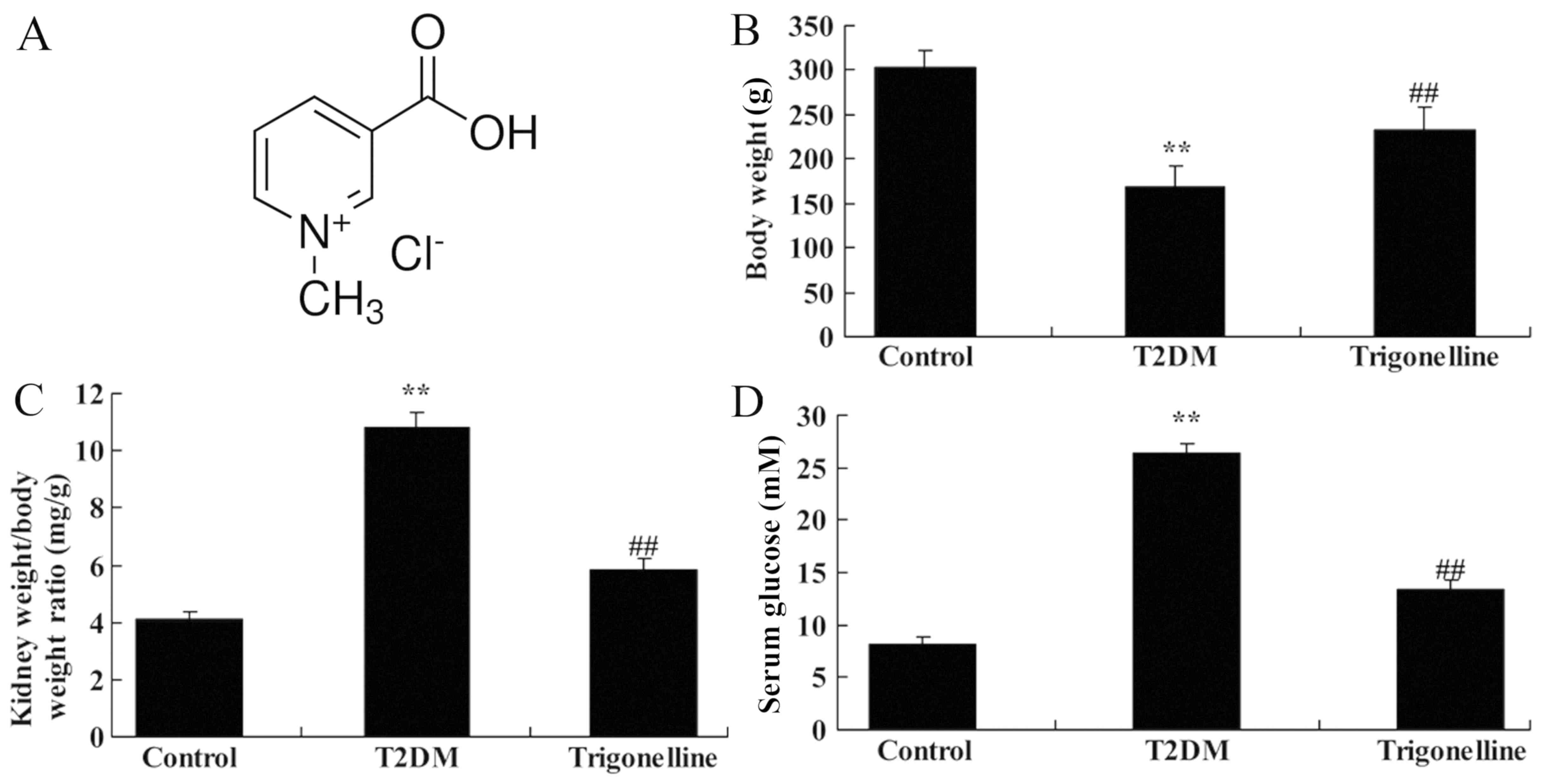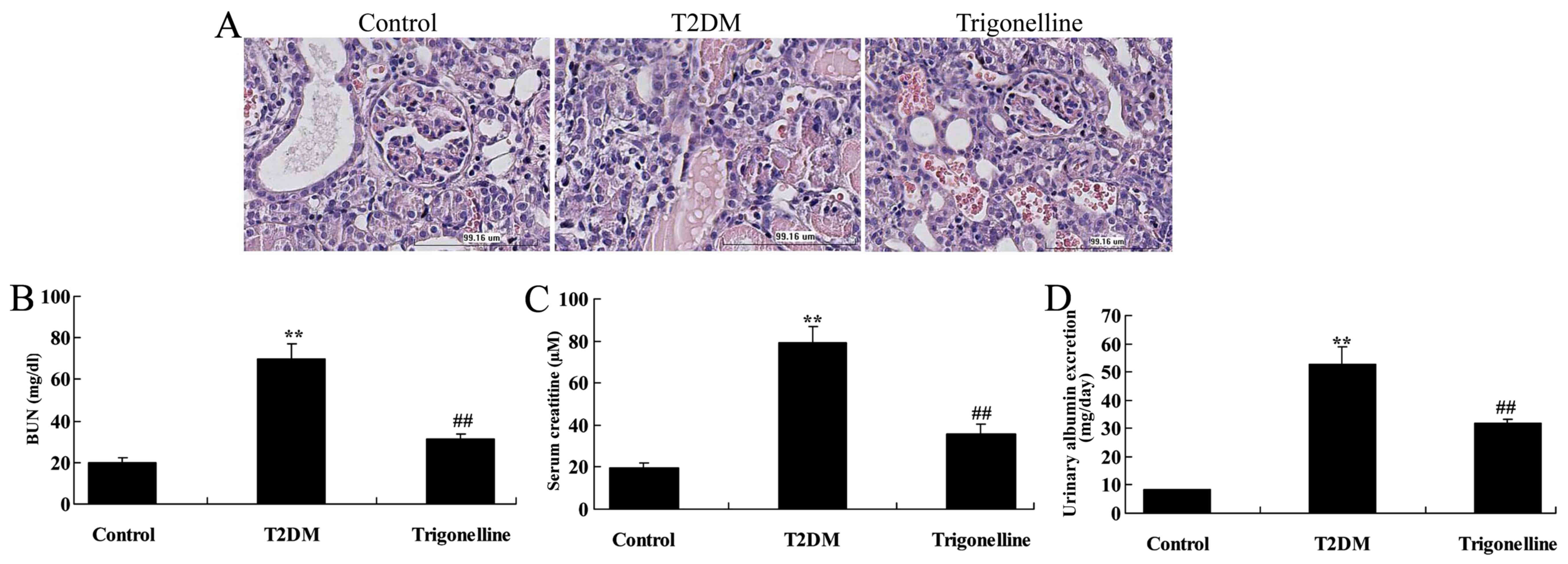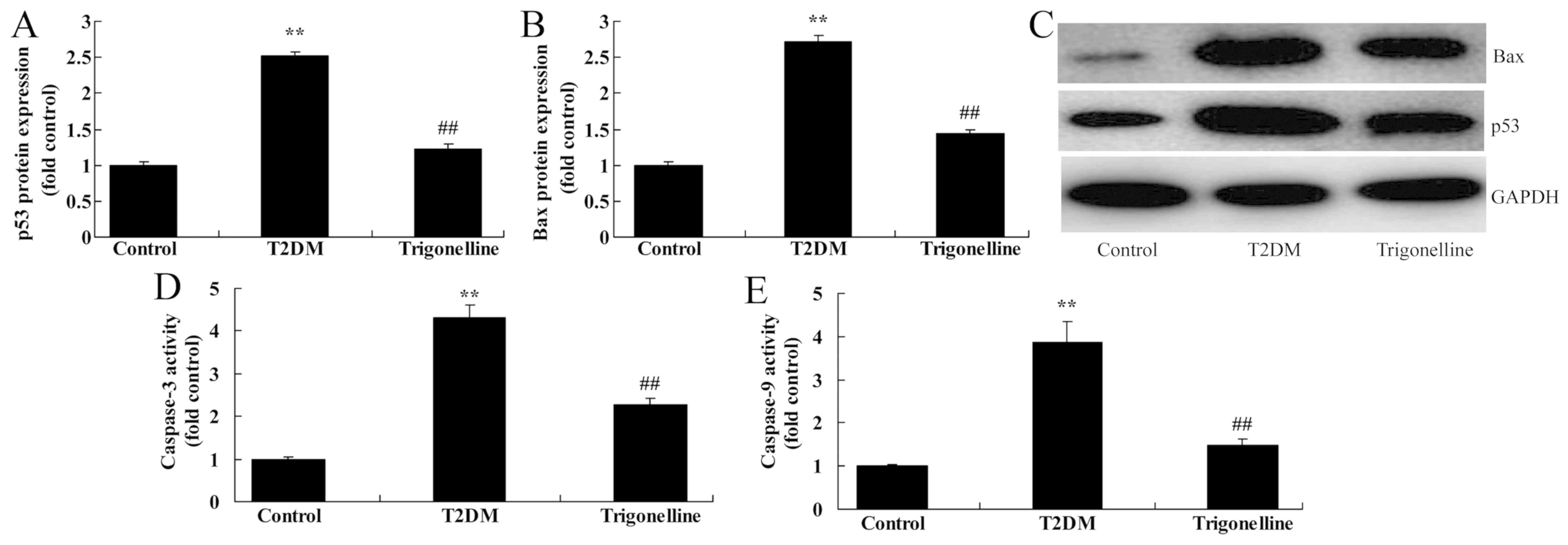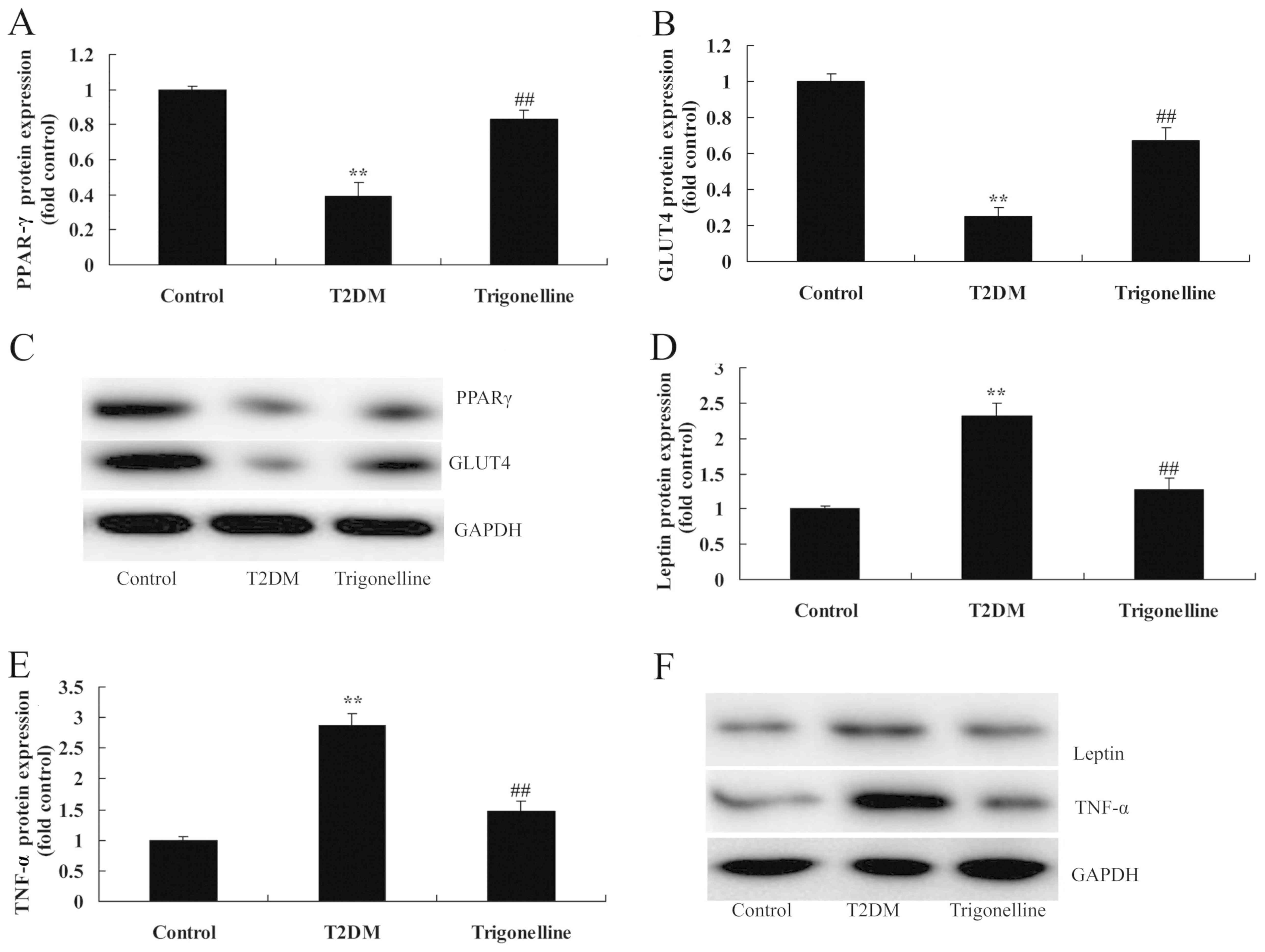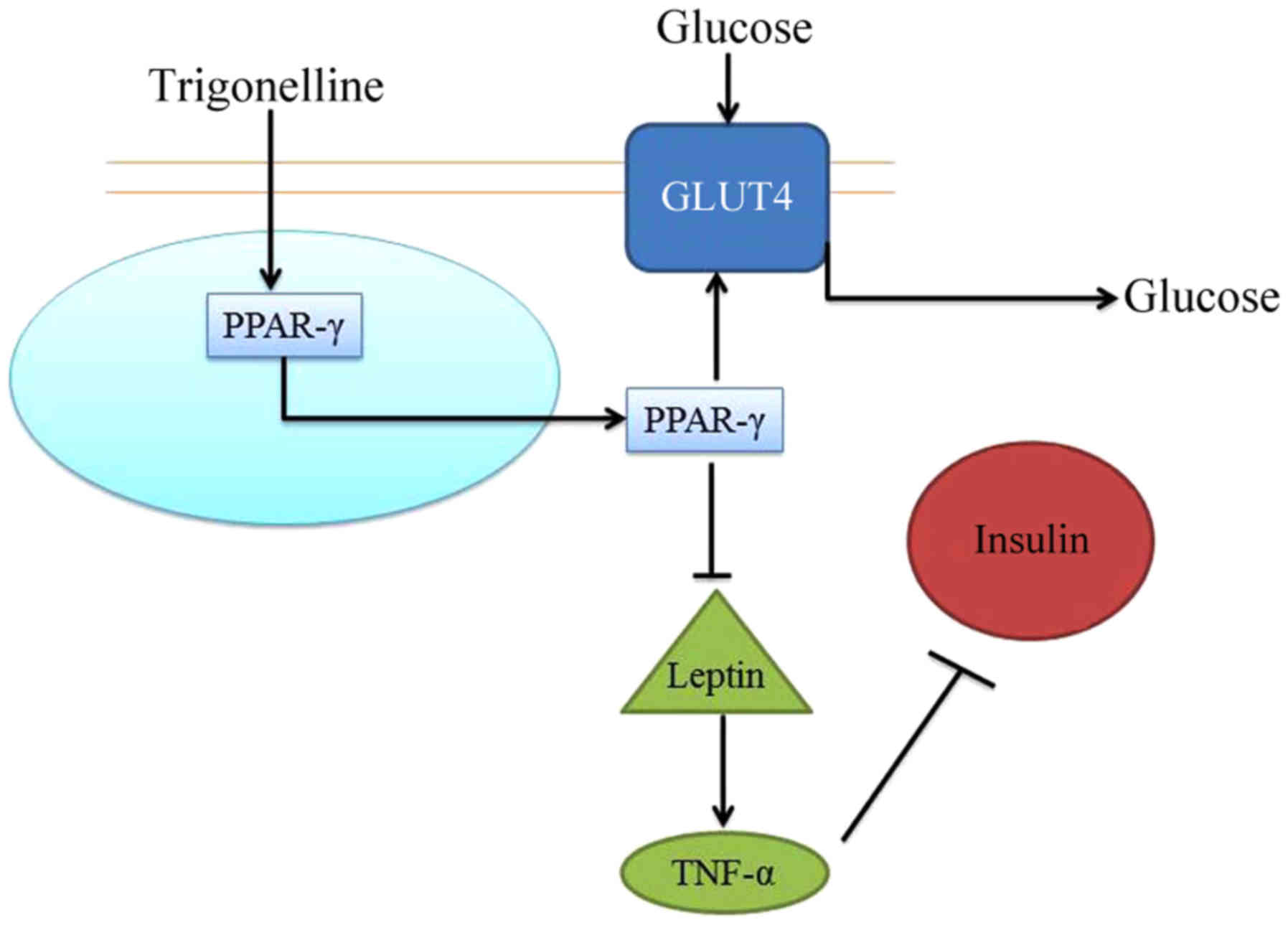Trigonelline reduced diabetic nephropathy and insulin resistance in type 2 diabetic rats through peroxisome proliferator‑activated receptor‑γ
- Authors:
- Published online on: June 21, 2019 https://doi.org/10.3892/etm.2019.7698
- Pages: 1331-1337
Abstract
Introduction
According to Chinese epidemiological studies in 2012, the morbidity of chronic kidney disease (CKD) in China is 10.0% and ~36.4% of the population have been diagnosed with diabetes (1). Research indicates that diabetes is an independent risk factor of CKD (1). According to the World Health Organization evaluation data, the population in China includes a total of 0.114 billion diabetics and 0.493 pre-diabetics (2). Importantly, the diabetic population is estimated to increase to 0.13 billion by 2025 (2). Diabetic nephropathy (DN) is a major complication of diabetes, which is also a leading cause of end-stage renal disease (ESRD) and dialysis in Western countries (3). The national dialysis registration quality control data (2012) in China indicate that 18.4% of new hemodialysis patients have DN. Furthermore, a total of 17.5% of the new peritoneal dialysis patients have DN. Notably, DN has become the second leading cause of ESRD and dialysis in China (3).
Numerous clinical studies have indicated that peroxisome proliferator-activated receptor (PPAR)-γ receptor agonist has favorable renal protective effects (4). PPAR-γ is extensively applied during the treatment of diabetes. Notably, PPARs are nuclear hormone receptor superfamily members (5) and nuclear transcription factors, which are activated by ligands. There are three major subtypes, namely, α, β and γ. Evidence indicates that PPAR-γ is widely expressed in glomerulus, renal proximal convoluted tubule, renal fibroblast and renal collecting tubule (6). Furthermore, research on the role of PPAR-γ in DN has attracted much attention in previous years (6).
Trigonelline is a major alkaloid isolated from the dry seed of Trigonella foenum-graecum L (7). It has been demonstrated to possess hypoglycemic, cholesterol-lowering, neural regeneration-promoting, anticancer and sedation effects (8). Notably, trigonelline can suppress β-amyloid protein in a dose-dependent manner (9). Furthermore, trigonelline has been demonstrated to induce neuron dendrite and axon atrophy, promote cerebral cortical neuron dendrite and axon regeneration (9), therefore protecting the central nervous system neuron (8). Zhou et al (8) suggested that trigonelline inhibits inflammation to prevent fetal growth restriction during pregnancy in diabetes. Furthermore, Ghule et al (10) indicated that trigonelline ameliorates diabetic hypertensive nephropathy. These findings suggest that trigonelline may be able to protect the central nervous system neurons.
Materials and methods
Experimental animals and induction of diabetes in rats
A total of 22 male Sprague-Dawley rats aged 5–6 weeks old (150–170 g) were housed in a temperature-controlled environment (temperature, 22–2°C; humidity, 55–5%) with a 12-h light/dark cycle and ad libitum access to food and water. All rats were randomly divided into three groups: Control (n=6), type 2 diabetes mellitus (T2DM) model (n=8) and trigonelline (n=8) groups. In T2DM model or trigonelline groups, rats were induced with T2DM. T2DM was induced in rats by feeding a high-fat diet (HFD, TP 28708, Trophi Feed High-tech Co., Ltd., Nantong, China) for 4 weeks. The T2DM model was confirmed when serum glucose were >16.7 mM. Subsequently, rats were intraperitoneally injected with 35 mg/kg of streptozotocin (Sigma-Aldrich; Merck KGaA, Darmstadt, Germany) for 4 weeks and were also fed a HFD during these additional 4 weeks. In the control group, rats were fed a standard diet for the total 8 weeks. The present study was approved by the Clinical Research and Experimental Animal Ethics Committee of the First Affiliated Hospital of China Medical University (Shenyang, China). In the trigonelline group, rats were received oral administration of 40 mg/kg/day of trigonelline (Sigma-Aldrich; Merck KGaA) for 8-weeks.
Histopathological analysis of animals
Following the administration of 35 mg/kg pentobarbital sodium (IV), rats were sacrificed by decapitation and the kidneys were collected. Samples were then washed with phosphate-buffered saline (PBS) and fixed in 10% neutral-buffered formalin for 24 h at room temperature. Kidney samples were processed using a routine paraffin embedding technique and 5-µm sections were prepared and stained with hematoxylin and eosin at room temperature for 15 min. Sections were observed using an inverted fluorescence microscope (magnification, ×100; Zeiss Axio Observer A1; Carl Zeiss AG, Oberkochen, Germany).
ELISA assay
Blood urea nitrogen (BUN; cat. no. C013-2), creatinine, albumin, interleukin (IL)-1β (cat. no. H002), IL-6 (cat. no. H007), IL-10 (cat. no. H009), IL-18 (cat. no. H015), malondialdehyde (MDA; cat. no. A003-1), superoxide dismutase (SOD; cat. no. A001-1-1), glutathione (GSH; cat. no. A006-2) and glutathione peroxidase (GSH-Px; cat. no. A005) levels were measured using ELISA kits (all from Nanjing Jiancheng Bioengineering Institute, Nanjing, China) following treatment with trigonelline. Caspase-3/9 levels were measured using Caspase-3/9 levels kits (cat. nos. C1116 and C1158, respectively; Beyotime Institute of Biotechnology, Haimen, China).
Western blot analysis
A total of 50 mg of kidney tissue samples was collected, washed with PBS and homogenized with radioimmunoprecipitation assay buffer (Beyotime Institute of Biotechnology) for 30 min at 4°C. Samples were centrifuged at 8,000 × g for 10 min at 4°C and the protein concentrations in the supernatants were quantified using a BCA assay. A total of 50 µg of total protein was separated using 10% SDS-PAGE electrophoresis and then transferred to nitro-cellulose membranes. Membranes were blocked with 5% non-fat milk for 1 h at 37°C and probed with Bax (cat. no. 5023; 1;2,000), p53 (cat. no. 2527; 1;2,000), glucose transporter 4 (GLUT4) (cat. no. 2213; 1;1,000), PPAR-γ (cat. no. 2443; 1;1,000), leptin (cat. no. 12497; 1;1,000), tumor necrosis factor (TNF)-α (cat. no. 11948; 1;1,000) and GAPDH antibodies (cat. no. 51332; 1;5,000; all Cell Signaling Technology, Inc., Danvers, MA, USA) at 4°C overnight. After washing with Tris-buffered saline with Tween-20 for 15–20 min, membranes were probed with secondary antibody labeled with horseradish peroxidase (7074, 7076, 1;5,000; Cell Signaling Technology, Inc.) for 1 h at 37°C. The protein bands were detected using enhanced chemiluminescent substrate (cat. no. P0018A; Beyotime Institute of Biotechnology) and quantified using Image Lab 3.0 (Bio-Rad Laboratories, Inc., Hercules, CA, USA).
Statistical analysis
Data were demonstrated as the mean ± standard deviation using SPSS 17.0 (SPSS, Inc., Chicago, IL, USA). Statistical analysis was performed using the Student's t-test or one-way analysis of variance followed by Tukey's post hoc test. P<0.05 was considered to indicate a statistically significant difference.
Results
Trigonelline increases body weight, inhibits the kidney weight/body weight ratio and blood glucose levels in T2DM rats
The chemical structure of trigonelline is presented in Fig. 1A. As indicated in Fig. 1B-D, T2DM resulted in significantly reduced body weight, elevated kidney weight/body weight ratio and increased blood glucose compared with the control group. However, oral administration of 40 mg/kg trigonelline in the trigonelline group for 60 days led to significantly increased body weight, suppressed kidney weight/body weight ratio and decreased blood glucose levels compared with T2DM group (Fig. 1B-D).
Trigonelline reduces the levels of BUN, creatinine and albumin in T2DM rats
It was indicated that the glomerulus, BUN, creatinine and albumin levels were increased in T2DM rats in comparison with control rats (Fig. 2). However, treatment with trigonelline recovered the glomerulus and reduced the levels of BUN, creatinine and albumin in T2DM rats (Fig. 2).
Trigonelline reduces inflammation in T2DM rats
Results indicated significantly increased levels of IL-1β, IL-6 and IL-18 but suppressed IL-10 levels in T2DM rats compared with control rats (Fig. 3). However, trigonelline treatment resulted in significantly decreased levels of IL-1β, IL-6 and IL-18 but increased IL-10 levels in T2DM rats (Fig. 3).
Trigonelline reduces oxidative stress in T2DM rats
Further analysis indicated significantly increased MDA levels, decreased levels of SOD, GSH and GSH-Px in T2DM rats compared with control rats (Fig. 4). Trigonelline administration significantly reduced MDA levels and promoted SOD, GSH and GSH-Px levels in T2DM rats (Fig. 4).
Trigonelline reduces cell apoptosis in T2DM rats
In order to investigate the mechanism of trigonelline in T2DM rats, the protein expression levels of Bax and p53 and the activity levels of caspase-3 and caspase-9 were analyzed. As indicated in Fig. 5, the protein expression levels of p53 and Bax and the activity levels of caspase-3 and caspase-9 were significantly increased in T2DM rats compared with control rats. Conversely, trigonelline administration significantly suppressed the protein expression levels of p53 and Bax and reduced the activity levels of caspase-3 and caspase-9 in T2DM rats (Fig. 5).
Trigonelline reduces insulin resistance in T2DM rats
To further explore the mechanism of trigonelline in T2DM rats, relevant proteins for insulin resistance were analyzed in T2DM rats. As indicated in Fig. 6, the protein expression levels of GLUT4 and PPAR-γ were significantly suppressed, whereas the protein expression levels of leptin and TNF-α were increased in T2DM rats in comparison with control rats (Fig. 6). However, trigonelline significantly induced GLUT4 and PPAR-γ protein expression, and suppressed leptin and TNF-α protein expression in T2DM rats, compared with the T2DM model group (Fig. 6).
Discussion
Diabetes is a metabolic disease that severely threatens human health. It can involve the whole body, leading to lesions in all organs, including the retina and kidneys (11). In recent years, changes in lifestyle have been witnessed (11). Consequently, the morbidity of T2DM characterized by insulin resistance is surging (11). DN has become the most common cause of ESRD in developed countries, including Japan and European and American countries (12). The results of the present study demonstrated that trigonelline significantly increased the body weight but decreased the kidney weight/body weight ratio and blood glucose levels in T2DM rats.
Various studies suggest that insulin resistance serves a vital role in the pathogenesis of diabetes (13,14). The role of local insulin resistance at a cellular level in target organ damage has received increased attention (13). Apart from classical insulin reactive cells, including adipocytes, skeletal muscle cells and hepatocytes (13), responses of cardiomyocytes, vascular endothelial cells and other types of cells in the kidney to insulin, as well as their influence, have become research hotspots (14). Notably, T2DM has also been indicated to be a chronic inflammatory disease (14). Numerous inflammatory factors, including cytokines and adhesion factors, directly participate in the development of insulin resistance and diabetic complications (14). Therefore, determining the effect and interaction mechanism of the two in DN damage is of importance to clinical work. Additionally, studying the possible mechanism of suppressing chronic inflammation to improve insulin resistance and relieve renal damage is also of important scientific and clinical value (14). The results of the present study suggested that trigonelline significantly reduced BUN, creatinine and albumin levels, indicating reduced inflammation in T2DM rats. Furthermore, Chowdhury et al (15) demonstrated that trigonelline protects against oxidative stress and proinflammatory cytokines in lipopolysaccharide-induced cognitive impairment in adult mice.
The high glucose status in diabetics typically induces glucose metabolic disorders, which results in the mass production of reactive oxygen species (ROS) (16). In this way, ROS can promote cross-linking polymerization of protein and nucleic acid. SOD, GSH and GSH-PX are important antioxidases, which can effectively eliminate ROS from the body to maintain the balance between oxidation and anti-oxidation (17). Thus, they can protect the cell from damage (16,17). In the present study, it was demonstrated that trigonelline reduced oxidative stress and cell apoptosis in T2DM rats. Notably, Afifi et al (18) concluded that trigonelline attenuates oxidative stress biomarkers in high-fat, high-fructose diet-induced insulin resistance in rats.
Previous studies have demonstrated that PPAR-γ and GLUT4 protein expression levels were downregulated at the time of diabetes (19). Additionally, upregulated PPAR-γ and GLUT4 protein expression levels are associated with protective effects against DN (20). GLUT4 is a transmembrane transport protein that promotes glucose transport to insulin-sensitive tissues for intracellular utilization (19). In this way, it can maintain normal physiological function of cells. PPAR-γ is a type of ligand-activated nuclear transcription factor (21) that is associated with fat differentiation, obesity and insulin resistance (22). Furthermore, PPAR-γ is the target molecule of euglycemic agents, such as thiazolidnediones (22). The results of the present study indicated that trigonelline increased GLUT4 and PPARγ protein expression levels in T2DM rats. Tharaheswari et al (9) suggested that trigonelline and diosgenin attenuated endoplasmic reticulum stress, oxidative stress-mediated damage and PPAR-γ activity in T2DM rats.
TNF-α is an early reactive cytokine, which can induce the downregulation or upregulation of other pro-inflammatory and anti-inflammatory mediators at the early stage of injury (23). In this way, TNF-α may induce an imbalanced inflammatory response (24). Previous findings have indicated that PPAR-γ participates in regulating the synthesis and secretion of multiple inflammatory mediators (24). Particularly, PPAR-γ serves a vital role in adipocyte differentiation, glucolipid metabolism and insulin resistance (24). PPAR-γ is a class of ligand-activated nuclear transcription factor that can regulate the expression of multiple key genes during glucose and lipid metabolism (25). Notably, leptin is involved in regulating glucose and lipid metabolism in the liver (25). Consequently, leptin may enhance the synthesis of triglycerides and reduce the production of hepatic glycogen (26). A previous study indicated that adipocytes can secrete multiple lipid cytokines and protein factors, among which, leptin, adiponectin, TNF-α and IL-6 are well-known (27). These components have been demonstrated to regulate the biological effect of insulin in target tissues by means of endocrine, paracrine and autocrine signaling (23). Importantly, they may serve critical roles in DN (28). TNF-α is a multi-functional inflammatory cytokine that has been associated with insulin levels, glucose metabolism and lipid metabolism (29). Furthermore, overexpression of TNF-α has been indicated in the lipid tissue of obese individuals (29). Notably, TNF-α acts on the peripheral target tissue and liver after it is released into the blood and thereby induces DN (29). Leptin is the product of the obese gene, which is a hormone secreted by adipocytes and released into blood (27). Research has indicated that there is a two-way regulation between leptin and insulin (27). In the present study, the results indicated that trigonelline suppressed leptin/TNF-α protein expression in T2DM rats. Zhou et al (8) suggested that trigonelline inhibits inflammation and protects β cells to prevent fetal growth restriction during pregnancy through leptin and insulin in diabetes. Antonisamy et al (7) revealed that trigonelline protected against indomethacin-induced gastric ulcers in rats through TNF-α. The present study suggested that trigonelline may regulate leptin/TNF-α to suppress insulin levels in T2DM rats.
In conclusion, the present study demonstrated that trigonelline increased the body weight, inhibited kidney weight/body weight ratio and blood glucose levels in T2DM rats. In addition, it was indicated that trigonelline may be associated with antioxidative, anti-inflammatory and anti-apoptotic mechanisms. The present findings suggest that trigonelline may reduce DN and insulin resistance in T2DM rats through a PPAR-γ/GLUT4-leptin/TNF-α signaling pathway (Fig. 7).
Acknowledgements
Not applicable.
Funding
No funding was received.
Availability of data and materials
The analyzed data sets generated during the study are available from the corresponding author on reasonable request.
Authors' contributions
QiL designed the experiments; YL, QaL, CW and ZL performed the experiments; QiL analyzed the data and wrote the manuscript. All authors read and approved the final manuscript.
Ethics approval and consent to participate
The present study was approved by the Clinical Research and Experimental Animal Ethics Committee of the First Affiliated Hospital of China Medical University (Shenyang, China).
Patient consent for publication
Not applicable.
Competing interests
The authors declare that they have no competing interests.
References
|
Hayer MK, Edwards NC, Slinn G, Moody WE, Steeds RP, Ferro CJ, Price AM, Andujar C, Dutton M, Webster R, et al: A randomized, multicenter, open-label, blinded end point trial comparing the effects of spironolactone to chlorthalidone on left ventricular mass in patients with early-stage chronic kidney disease: Rationale and design of the SPIRO-CKD trial. Am Heart J. 191:37–46. 2017. View Article : Google Scholar : PubMed/NCBI | |
|
Bouchi R, Nakano Y, Fukuda T, Takeuchi T, Murakami M, Minami I, Izumiyama H, Hashimoto K, Yoshimoto T and Ogawa Y: Reduction of visceral fat by liraglutide is associated with ameliorations of hepatic steatosis, albuminuria, and micro-inflammation in type 2 diabetic patients with insulin treatment: A randomized control trial. Endocr J. 64:269–281. 2017. View Article : Google Scholar : PubMed/NCBI | |
|
Nakamura T, Sato E, Amaha M, Kawagoe Y, Maeda S and Yamagishi S: Addition of aliskiren to angiotensin II receptor blockers ameliorates renal tubular injury and reduces intima media thickness of carotid artery in patients with diabetic nephropathy. Int J Cardiol. 155:294–296. 2012. View Article : Google Scholar : PubMed/NCBI | |
|
Gandhi GR, Jothi G, Antony PJ, Balakrishna K, Paulraj MG, Ignacimuthu S, Stalin A and Al-Dhabi NA: Gallic acid attenuates high-fat diet fed-streptozotocin-induced insulin resistance via partial agonism of PPARγ in experimental type 2 diabetic rats and enhances glucose uptake through translocation and activation of GLUT4 in PI3K/p-Akt signaling pathway. Eur J Pharmacol. 745:201–216. 2014. View Article : Google Scholar : PubMed/NCBI | |
|
Tsukahara R, Haniu H, Matsuda Y and Tsukahara T: The AGP-PPARγ axis promotes oxidative stress and diabetic endothelial cell dysfunction. Mol Cell Endocrinol. 473:100–113. 2018. View Article : Google Scholar : PubMed/NCBI | |
|
Fu H, Desvergne B, Ferrari S and Bonnet N: Impaired musculoskeletal response to age and exercise in PPARβ(−/-) diabetic mice. Endocrinology. 155:4686–4696. 2014. View Article : Google Scholar : PubMed/NCBI | |
|
Antonisamy P, Arasu MV, Dhanasekaran M, Choi KC, Aravinthan A, Kim NS, Kang CW and Kim JH: Protective effects of trigonelline against indomethacin-induced gastric ulcer in rats and potential underlying mechanisms. Food Funct. 7:398–408. 2016. View Article : Google Scholar : PubMed/NCBI | |
|
Zhou JY, Du XH, Zhang Z and Qian GS: Trigonelline inhibits inflammation and protects β cells to prevent fetal growth restriction during pregnancy in a mouse model of diabetes. Pharmacology. 100:209–217. 2017. View Article : Google Scholar : PubMed/NCBI | |
|
Tharaheswari M, Jayachandra Reddy N, Kumar R, Varshney KC, Kannan M and Sudha Rani S: Trigonelline and diosgenin attenuate ER stress, oxidative stress-mediated damage in pancreas and enhance adipose tissue PPARγ activity in type 2 diabetic rats. Mol Cell Biochem. 396:161–174. 2014. View Article : Google Scholar : PubMed/NCBI | |
|
Ghule AE, Jadhav SS and Bodhankar SL: Trigonelline ameliorates diabetic hypertensive nephropathy by suppression of oxidative stress in kidney and reduction in renal cell apoptosis and fibrosis in streptozotocin induced neonatal diabetic (nSTZ) rats. Int Immunopharmacol. 14:740–748. 2012. View Article : Google Scholar : PubMed/NCBI | |
|
Lindhardt M, Persson F, Currie G, Pontillo C, Beige J, Delles C, von der Leyen H, Mischak H, Navis G, Noutsou M, et al: Proteomic prediction and Renin angiotensin aldosterone system Inhibition prevention Of early diabetic nephRopathy in TYpe 2 diabetic patients with normoalbuminuria (PRIORITY): essential study design and rationale of a randomised clinical multicentre trial. BMJ Open. 6:e0103102016. View Article : Google Scholar : PubMed/NCBI | |
|
Imai E, Chan JC, Ito S, Yamasaki T, Kobayashi F, Haneda M and Makino H; ORIENT study investigators, : Effects of olmesartan on renal and cardiovascular outcomes in type 2 diabetes with overt nephropathy: A multicentre, randomised, placebo-controlled study. Diabetologia. 54:2978–2986. 2011. View Article : Google Scholar : PubMed/NCBI | |
|
Tziastoudi M, Stefanidis I, Hadjigeorgiou GM, Stravodimos K and Zintzaras E: A systematic review and meta-analysis of genetic association studies for the role of inflammation and the immune system in diabetic nephropathy. Clin Kidney J. 10:293–300. 2017. View Article : Google Scholar : PubMed/NCBI | |
|
Chen Y, Liang Y, Hu T, Wei R, Cai C, Wang P, Wang L, Qiao W and Feng L: Endogenous Nampt upregulation is associated with diabetic nephropathy inflammatory-fibrosis through the NF-κB p65 and Sirt1 pathway; NMN alleviates diabetic nephropathy inflammatory-fibrosis by inhibiting endogenous Nampt. Exp Ther Med. 14:4181–4193. 2017.PubMed/NCBI | |
|
Chowdhury AA, Gawali NB, Munshi R and Juvekar AR: Trigonelline insulates against oxidative stress, proinflammatory cytokines and restores BDNF levels in lipopolysaccharide induced cognitive impairment in adult mice. Metab Brain Dis. 33:681–691. 2018. View Article : Google Scholar : PubMed/NCBI | |
|
Suresha BS and Srinivasan K: Fungal metabolite nigerloxin ameliorates diabetic nephropathy and gentamicin-induced renal oxidative stress in experimental rats. Naunyn Schmiedebergs Arch Pharmacol. 387:849–859. 2014. View Article : Google Scholar : PubMed/NCBI | |
|
Volpe CMO, Villar-Delfino PH, Dos Anjos PMF and Nogueira-Machado JA: Cellular death, reactive oxygen species (ROS) and diabetic complications. Cell Death Dis. 9:1192018. View Article : Google Scholar : PubMed/NCBI | |
|
Afifi NA, Ramadan A, Erian EY, Saleh DO, Sedik AA, Badawi M and El Hotaby W: Trigonelline attenuates hepatic complications and molecular alterations in high-fat high-fructose diet-induced insulin resistance in rats. Can J Physiol Pharmacol. 95:427–436. 2017. View Article : Google Scholar : PubMed/NCBI | |
|
Irudayaraj SS, Stalin A, Sunil C, Duraipandiyan V, Al-Dhabi NA and Ignacimuthu S: Antioxidant, antilipidemic and antidiabetic effects of ficusin with their effects on GLUT4 translocation and PPARγ expression in type 2 diabetic rats. Chem Biol Interact. 256:85–93. 2016. View Article : Google Scholar : PubMed/NCBI | |
|
Zhou Z, Wan J, Hou X, Geng J, Li X and Bai X: MicroRNA-27a promotes podocyte injury via PPARγ-mediated β-catenin activation in diabetic nephropathy. Cell Death Dis. 8:e26582017. View Article : Google Scholar : PubMed/NCBI | |
|
Wasik AA, Dumont V, Tienari J, Nyman TA, Fogarty CL, Forsblom C, Lehto M, Lehtonen E, Groop PH and Lehtonen S: Septin 7 reduces nonmuscle myosin IIA activity in the SNAP23 complex and hinders GLUT4 storage vesicle docking and fusion. Exp Cell Res. 350:336–348. 2017. View Article : Google Scholar : PubMed/NCBI | |
|
Ge J, Miao JJ, Sun XY and Yu JY: Huangkui capsule, an extract from Abelmoschus manihot (L.) medic, improves diabetic nephropathy via activating peroxisome proliferator-activated receptor (PPAR)-α/γ and attenuating endoplasmic reticulum stress in rats. J Ethnopharmacol. 189:238–249. 2016. View Article : Google Scholar : PubMed/NCBI | |
|
Umapathy D, Krishnamoorthy E, Mariappanadar V, Viswanathan V and Ramkumar KM: Increased levels of circulating (TNF-α) is associated with (−308G/A) promoter polymorphism of TNF-α gene in Diabetic Nephropathy. Int J Biol Macromol 107B. 2113–2121. 2018. View Article : Google Scholar | |
|
Jia Z, Xinhua X, Qian Z, Miao Y, Jianping X, Zhixin W, Yijing L and Mingmin L: PPARγ links maternal malnutrition and abnormal glucose and lipid metabolism in the offspring of mice. Yi Chuan. 37:70–76. 2015.PubMed/NCBI | |
|
Wang X, Shi L, Joyce S, Wang Y and Feng Y: MDG-1, a potential regulator of PPARα and PPARγ, ameliorates dyslipidemia in mice. Int J Mol Sci. 18:182017. | |
|
Wu J, Ding Y, Zhu C, Shao X, Xie X, Lu K and Wang R: Urinary TNF-α and NGAL are correlated with the progression of nephropathy in patients with type 2 diabetes. Exp Ther Med. 6:1482–1488. 2013. View Article : Google Scholar : PubMed/NCBI | |
|
González-Clemente JM, Mauricio D, Richart C, Broch M, Caixàs A, Megia A, Giménez-Palop O, Simón I, Martínez-Riquelme A, Giménez-Pérez G, et al: Diabetic neuropathy is associated with activation of the TNF-alpha system in subjects with type 1 diabetes mellitus. Clin Endocrinol (Oxf). 63:525–529. 2005. View Article : Google Scholar : PubMed/NCBI | |
|
Li X, Wu TT, Chen J and Qiu W: Elevated expression levels of serum insulin-like growth factor-1, tumor necrosis factor-α and vascular endothelial growth factor 165 might exacerbate type 2 diabetic nephropathy. J Diabetes Investig. 8:108–114. 2017. View Article : Google Scholar : PubMed/NCBI | |
|
Kozłowska L, Rydzewski A, Fiderkiewicz B, Wasińska-Krawczyk A, Grzechnik A and Rosołowska-Huszcz D: Adiponectin, resistin and leptin response to dietary intervention in diabetic nephropathy. J Ren Nutr. 20:255–262. 2010. View Article : Google Scholar : PubMed/NCBI |



